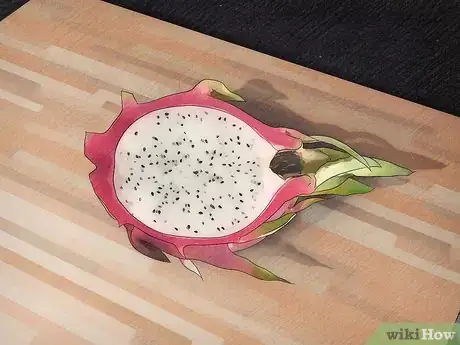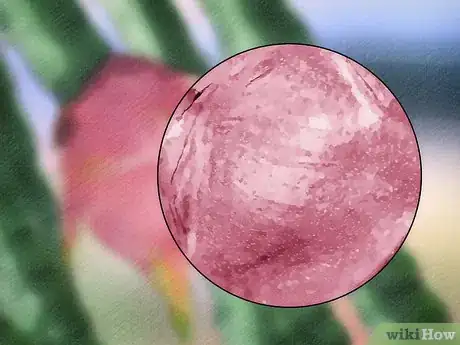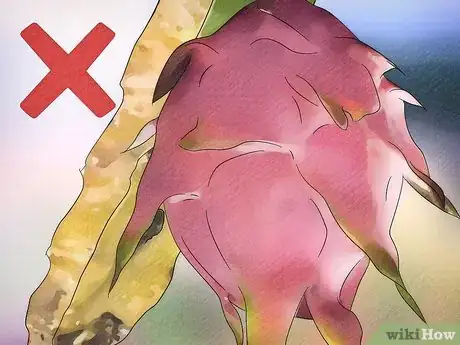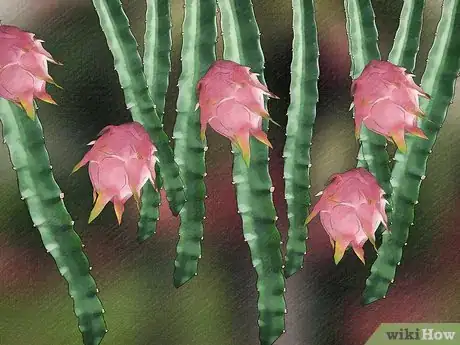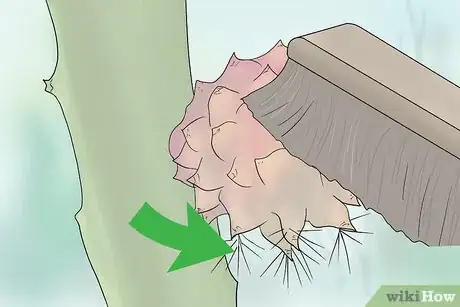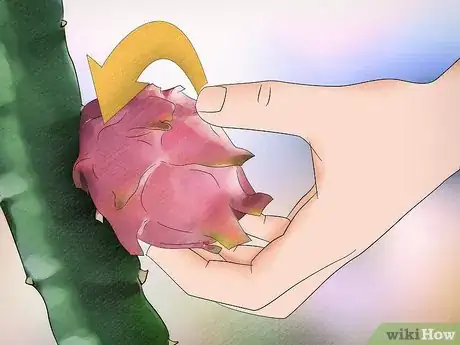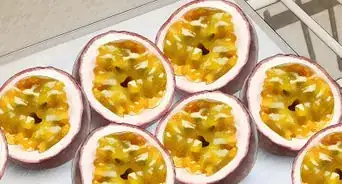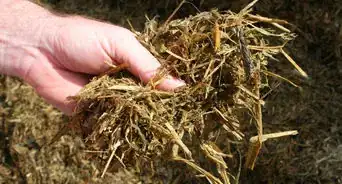This article was co-authored by Andrew Carberry, MPH. Andrew Carberry is a Food Systems Expert and the Senior Program Associate at the Wallace Centere at Winrock International in Little Rock, Arkansas. He has worked in food systems since 2008 and has experience working on farm-to-school projects, food safety programs, and working with local and state coalitions in Arkansas. He is a graduate of the College of William and Mary and holds a Masters degree in public health and nutrition from the University of Tennessee.
wikiHow marks an article as reader-approved once it receives enough positive feedback. This article received 13 testimonials and 83% of readers who voted found it helpful, earning it our reader-approved status.
This article has been viewed 544,513 times.
Dragon fruit, or pitaya, are cactus fruit that come in three types. They can have either red or yellow skin. The varieties with red skin can have white or red flesh, while the yellow-skinned variety has white flesh. For any of the three varieties, you can determine if a dragon fruit is ripe by looking at and touching the fruit before eating. If you grow your own dragon fruits, harvest your fruits at the right time to ensure ripeness.
Steps
Looking at a Dragon Fruit to Determine its Ripeness
-
1Look for dragon fruit that is red or yellow in color. When a dragon fruit is not ripe it will be green in color. As the fruit matures and ripens, the outer skin color changes to red or yellow, depending on the variety.[1]
- When ripe the outer skin should be bright and even-colored. If the fruit has a lot of dark blotches on the skin, similar to bruises on an apple, then it may be overripe. A few spots, however, are normal.
-
2Determine if the “wings” on the fruit have started to wither. Dragon fruit wings are the leafy part that extend off of the fruit. When they start to dry out, turn brown, and wither, the dragon fruit is ripe and ready to be eaten. Conversely, if the wings are still colorful (ie red or yellow), that means the fruit is underripe and still needs more time to ripen.[2]
- Once the dragon fruit has reached the stage of ripeness where the wings start to wither, the fruit should come off the vine fairly easily with a light twist. If the fruit falls off the vine on its own, it is overripe.
Advertisement -
3Cut open the dragon fruit. The inside of a dragon fruit is usually white, deep pink, or purple, depending on the variety, and contains tiny black seeds. The black seeds are edible and are similar in appearance to those found in a kiwi. When ripe the inside of a dragon fruit should appear juicy yet firm in texture: like a cross between a melon and a pear.[3]
- When a dragon fruit is overripe the inner flesh will turn brown in color, similar to the bruised flesh of a banana. You should not eat fruit that is brown or dried out.
Touching a Dragon Fruit to See if it is Ripe
-
1Press the dragon fruit gently with your thumb. Hold the dragon fruit in your palm and try pressing the skin with your thumb or fingers. It should be soft, but not too mushy. If it is really mushy, then the fruit is likely overripe. If it’s very firm, it will need a few days to ripen.[4]
- Only use this method if you are growing and harvesting your own dragon fruit. Squeezing a dragon fruit can leave the fruit bruised, which is inconsiderate to vendors and other customers in a store or market setting.
- You can purchase or harvest a dragon fruit that is underripe and leave it out on a counter for a few days at room temperature. It will likely ripen in a couple days. Test the ripeness daily by pressing the skin.
-
2Check for impurities or damage to the skin. Dragon fruit can get damaged skin from rough handling and transportation mishaps. For example, if the fruit is not packaged properly during transportation, they may roll into each other. They might also become bruised from being dropped. If damaged the fruit will contain noticeable blemishes and will be much smaller and shriveled due to moisture loss.[5]
- Check all sides of the fruit and avoid purchasing fruit that has been cracked, split open, or damaged.
-
3Avoid fruits with dried out stems. One sign that a dragon fruit may be overripe is a dried out stem. Touch the fruit to determine if the stem is brittle, shriveled, and dried out.[6]
Harvesting Dragon Fruit at the Appropriate Time
-
1Harvest dragon fruits when they are close to fully ripe. Dragon fruits, unlike many other fruits, do not ripen as much after harvest and as a result should be harvested when they are almost fully ripe.[7]
- Once the color of the fruit has changed from green to yellow or red, then it is ready to harvest.
- The small leaves on the sides of the fruit (also known as the “wings”) will also start to fade or turn brown as the fruit ripens.
- You can also determine the ripeness by counting the days after the plant flowers. Typically the fruit is ripe a minimum of 27 to 33 days after the plant flowers.
- Proper time of harvesting is four days after the color of the fruit changes. For export purpose, however, it is important to harvest slightly sooner, a day after the color changes.
-
2Remove the thorns from the fruit before picking. You can remove the thorns by using pliers, brushing them off, or with gloves. When the fruit is ripe the needles should begin to shed anyways, and as a result they should not be too difficult to remove. However, you should always wear gloves and be cautious because the needles are very sharp.[8]
-
3Detach the dragon fruit from the vine by twisting. When a dragon fruit is ripe and ready to be harvested, it will detach from the plant easily by twisting a few times. If you have to pull too hard on the fruit then it is likely not ready to be harvested.
- Do not wait until the dragon fruit has fallen off the plant. This means that the fruit is overripe.
Our Most Loved Articles & Quizzes
Expert Q&A
-
QuestionWhat time of year should you eat a dragon fruit?
 Andrew Carberry, MPHAndrew Carberry is a Food Systems Expert and the Senior Program Associate at the Wallace Centere at Winrock International in Little Rock, Arkansas. He has worked in food systems since 2008 and has experience working on farm-to-school projects, food safety programs, and working with local and state coalitions in Arkansas. He is a graduate of the College of William and Mary and holds a Masters degree in public health and nutrition from the University of Tennessee.
Andrew Carberry, MPHAndrew Carberry is a Food Systems Expert and the Senior Program Associate at the Wallace Centere at Winrock International in Little Rock, Arkansas. He has worked in food systems since 2008 and has experience working on farm-to-school projects, food safety programs, and working with local and state coalitions in Arkansas. He is a graduate of the College of William and Mary and holds a Masters degree in public health and nutrition from the University of Tennessee.
Food Systems Expert Dragon fruit harvest is generally mid summer through early fall.
Dragon fruit harvest is generally mid summer through early fall. -
QuestionWhen should I harvest dragon fruit?
 Andrew Carberry, MPHAndrew Carberry is a Food Systems Expert and the Senior Program Associate at the Wallace Centere at Winrock International in Little Rock, Arkansas. He has worked in food systems since 2008 and has experience working on farm-to-school projects, food safety programs, and working with local and state coalitions in Arkansas. He is a graduate of the College of William and Mary and holds a Masters degree in public health and nutrition from the University of Tennessee.
Andrew Carberry, MPHAndrew Carberry is a Food Systems Expert and the Senior Program Associate at the Wallace Centere at Winrock International in Little Rock, Arkansas. He has worked in food systems since 2008 and has experience working on farm-to-school projects, food safety programs, and working with local and state coalitions in Arkansas. He is a graduate of the College of William and Mary and holds a Masters degree in public health and nutrition from the University of Tennessee.
Food Systems Expert Harvest your dragon fruit when the wings on the sides of the fruit begin to fade in color.
Harvest your dragon fruit when the wings on the sides of the fruit begin to fade in color. -
QuestionIs it bad if a dragon fruit leaks juice?
 Community AnswerIf your dragon fruit it leaking juice it likely means that the skin was damaged at some point during handling and transportation. As a result the interior of the fruit may not be as juicy as normal and the fruit may be dried out. Avoid fruits that are leaking when at the grocery store or market.
Community AnswerIf your dragon fruit it leaking juice it likely means that the skin was damaged at some point during handling and transportation. As a result the interior of the fruit may not be as juicy as normal and the fruit may be dried out. Avoid fruits that are leaking when at the grocery store or market.
References
- ↑ https://blog.nurserylive.com/2017/07/08/how-to-pick-a-dragon-fruit-and-gardening-in-india
- ↑ https://blog.nurserylive.com/2017/07/08/how-to-pick-a-dragon-fruit-and-gardening-in-india
- ↑ http://www.specialtyproduce.com/produce/Red_Dragon_Fruit_Pitaya_1439.php
- ↑ [[http://www.healwithfood.org/how-to-eat/dragon-fruit-pitahaya.php
- ↑ http://postharvest.ucdavis.edu/Commodity_Resources/Fact_Sheets/Datastores/Fruit_English/?uid=49&ds=798
- ↑ http://parade.com/62212/linzlowe/what-the-heck-is-a-dragon-fruit-and-how-do-you-eat-it/
- ↑ https://selfsufficientme.com/dragon-fruit-pitaya-how-to-guide-for-growing/
- ↑ https://selfsufficientme.com/dragon-fruit-pitaya-how-to-guide-for-growing/
About This Article
If you want to tell if a dragon fruit is ripe, first look for fruit that is red or yellow, since a green fruit means it’s unripe. Next, pick one in which the leafy wings coming off the fruit have started to wither and brown, because that’s a good sign that it’s ready to eat. Additionally, check that the dragon fruit is soft, but not mushy when you gently push it with your thumb. If it’s still very firm, it needs a few more days to ripen.


